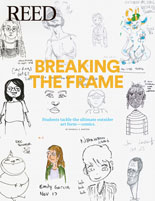
IRIS login | Reed College home Volume 96, No. 1: March 2017
Reediana
Field Theories (Nightboat, 2017)
By Prof. Samiya Bashir [creative writing 2012–]
Reviewed by Bonnie Arning

When first diving in to Prof. Samiya Bashir’s Field Theories, you wonder what type of theories you will encounter: mathematical, physical, quantum, physiological, or social? The answer is, all of them. In Bashir’s third full-length collection, she surveys multiplicities of existence. The speaker grapples with what it means to exist as a blackbody on our “sickening ball of melt.”
Bashir’s pursuit takes us on a journey unlike any we’ve previously known. We travel through epochs of time and encounter wooly mammoths and Eocene camels. Jazz riffs float along our periphery. We shift our gaze from mythological figures, to fast-food workers, and alchemists. We delve into physics, quantum mechanics, and mathematics. We oscillate between the terrestrial and the astral. Voices of black folk heroes like John Henry and Polly Ann ring out alongside prominent black cultural icons like Mae Carol Jemison and Neil deGrasse Tyson.

Unless well versed in all academic disciplines, reading Field Theories will force you to research. Each Googled term will pull you further and further into another world, which perhaps is the world we live in, but another dimension of it—one in which the invisible becomes visible, the overlooked, suddenly called to attention. This palimpsest in flux where people and artifacts exist across time and theories is so imagistically, linguistically and theoretically robust, Bashir convinces us that their separation in our own dimension is only a stubbornly persistent illusion.
Beyond being thematically inventive, her notion of omnipresence is powerful and political. It quashes the cultural impulse to label incidents of racism as isolated. Bashir artfully disabuses us of our belief in isolation and allows us to experience the multifaceted beauty inherent in our absurd existence. In the title poem, among images of mattress stains and cat puke, she insists, again and again, “What is a thing of beauty if not us?”
Furthermore, Bashir’s structural innovation delights and dazzles. Poems sprawl. Lines read vertically and jut out into diagonals. Often, Bashir transmogrifies language by imbedding mathematical symbols into the line. Meaning becomes duplicated and amplified. She superimposes the world of feeling upon the world of logic and certainty in a way that makes us wonder how we ever considered them in opposition.
Though ambitious and innovative, ambition and invention are not Field Theories’ greatest accomplishments. Most surprising is the way this book will alter the way you feel about the world around you, and, more importantly, your understanding of what it means to be human.

LATEST COMMENTS
steve-jobs-1976 I knew Steve Jobs when he was on the second floor of Quincy. (Fall...
Utnapishtim - 2 weeks ago
Prof. Mason Drukman [political science 1964–70] This is gold, pure gold. God bless, Prof. Drukman.
puredog - 1 month ago
virginia-davis-1965 Such a good friend & compatriot in the day of Satyricon...
czarchasm - 4 months ago
John Peara Baba 1990 John died of a broken heart from losing his mom and then his...
kodachrome - 7 months ago
Carol Sawyer 1962 Who wrote this obit? I'm writing something about Carol Sawyer...
MsLaurie Pepper - 8 months ago
William W. Wissman MAT 1969 ...and THREE sisters. Sabra, the oldest, Mary, the middle, and...
riclf - 10 months ago